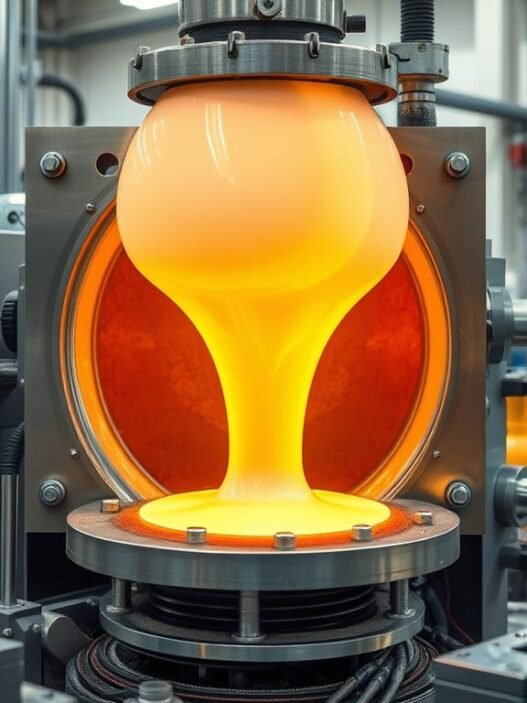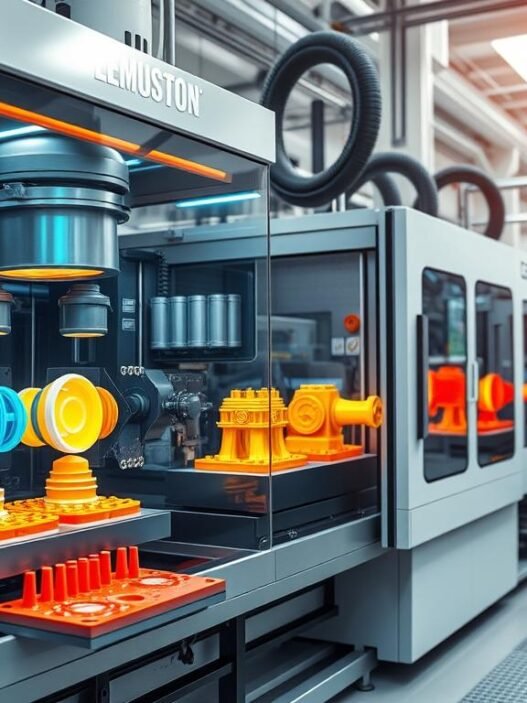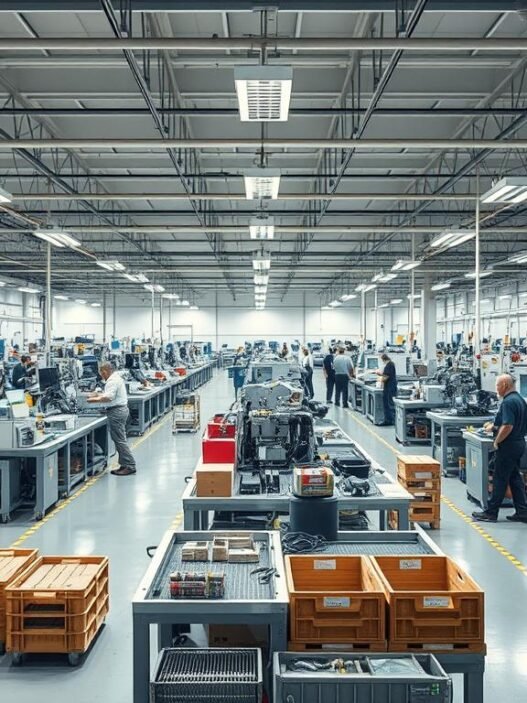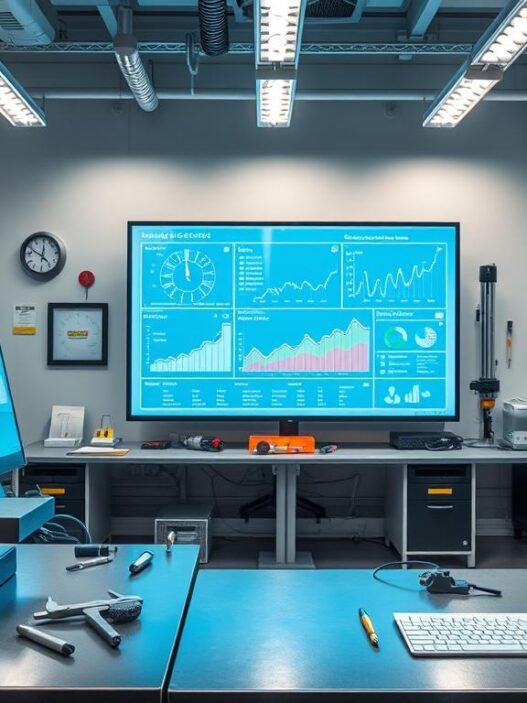In the world of materials science, thermoplastic polymers are a big deal. They offer versatility, recyclability, and top-notch performance. But what are they, and how are they changing industries worldwide? Let’s dive into the world of thermoplastic materials and see how they’re making waves in engineering and manufacturing.
Key Takeaways
- Thermoplastic polymers are known for their recyclability and diverse range of applications.
- They are composed of monomers that form branches or chains, and can be softened and remolded with heat.
- Thermoplastics are widely used in injection molding due to their strong, flexible, and shrink-resistant properties.
- Thermoplastic materials are suitable for both low and high-stress applications.
- The curing process for thermoplastics is reversible, allowing for easy recycling without compromising their physical qualities.
What are Thermoplastic Polymers?
Definition and Characteristics
Thermoplastics are plastics that get soft when heated and hard when cooled. This lets them be molded and reshaped many times without losing quality. They are different from thermosets because they can be melted and reshaped again and again.
These plastics are special because they can soften and melt with heat, then solidify when cooled. This is what makes them different from thermosets, which can’t be reshaped or recycled.
Thermoplastics are known for being flexible, tough, and resistant to impact. Their structure is usually linear or branched. This helps them keep their shape when melted and reshaped.
They are used in many things, from everyday items to industrial parts. Their versatility and easy processing make them a top choice for many needs.
“Thermoplastics are the most widely used type of plastic, accounting for over 80% of all plastic production worldwide.”
Thermoplastic Polymers
Thermoplastic materials can be melted, molded, and solidified many times without losing their properties. This makes them very versatile and recyclable. They are divided into two main types: commodity thermoplastics and engineered thermoplastics.
Commodity thermoplastics are cheap and used in many everyday items. Examples include plastic bottles, containers, and packaging. These are made from materials like polyethylene (PE), polypropylene (PP), polystyrene (PS), and polyvinyl chloride (PVC).
Engineered thermoplastics, however, are made to meet specific needs. They are used in industries like the military, aerospace, and automotive. These materials have better strength, heat resistance, and chemical stability.
Thermoplastic materials can be melted and molded again and again. This makes them great for recycling and sustainable manufacturing. Their ability to be reused and recycled is key to their importance in today’s world.
| Commodity Thermoplastics | Engineered and Specialized Thermoplastics |
|---|---|
|
|
Thermoplastic polymers are essential in our daily lives. They are used in many products and technologies. Their versatility and wide range of applications make them crucial in the modern world.
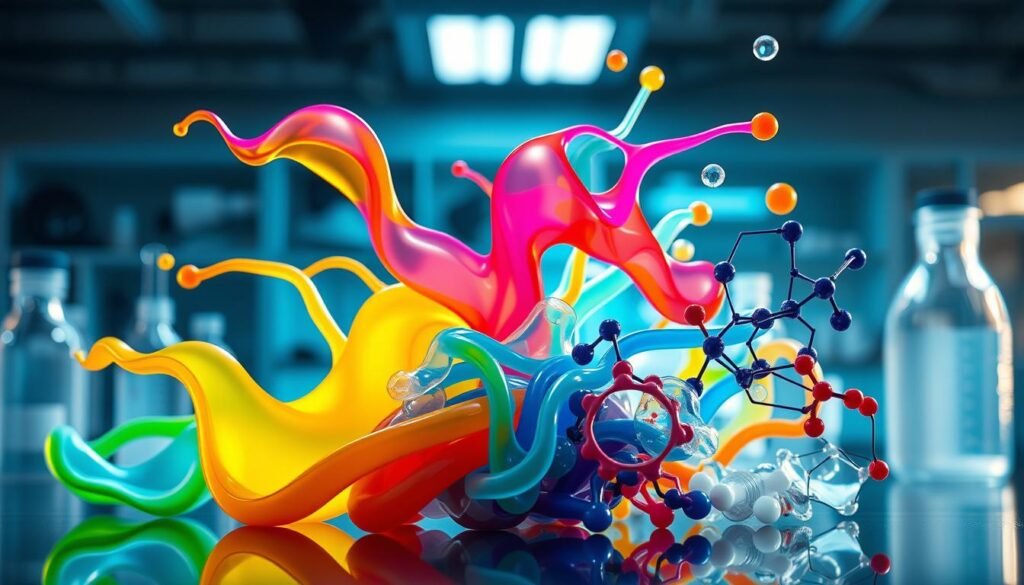
Common Types of Thermoplastic Polymers
Thermoplastic polymers come in many forms, each with its own set of properties and uses. Two of the most common are polyethylene (PE) and polypropylene (PP).
Polyethylene (PE)
Polyethylene is known for being water-resistant, stable, hard, and stiff. It’s used in many ways, like packaging, agriculture, and insulation for wires and cables. Its ability to handle the environment well makes it a favorite in many industries.
Polypropylene (PP)
Polypropylene is also very popular. It’s light, and it can handle heat, chemicals, and electricity well. It’s used in things like lab equipment, carpets, textiles, and packaging. Its strength and flexibility make it a key material in many products.
Polyethylene and polypropylene are just a few examples of the many thermoplastic polymer types out there. Each has its own thermoplastic polymer properties and thermoplastic polymer applications. These materials are changing many industries and helping create the products we use daily.
Specialized Thermoplastic Polymers
There are more than just common thermoplastics like polyethylene (PE) and polypropylene (PP). Polyvinyl Chloride (PVC) and Polycarbonate (PC) are examples of specialized thermoplastics. They have unique properties and uses.
Polyvinyl Chloride (PVC)
Polyvinyl Chloride (PVC) is a strong, light, and flexible material. It resists many chemicals, making it great for building materials like vinyl siding and pipes. Its strength and affordability make it popular in construction and infrastructure.
Polycarbonate (PC)
Polycarbonate (PC) is known for its toughness, stability, heat resistance, and clarity. These qualities make it ideal for injection molding. It’s used in kitchen items, electronics, and safety gear.
Thermoplastics like PVC and PC have special benefits. They meet specific needs in industries, adding to the versatility of common thermoplastics.
| Thermoplastic Polymer | Key Properties | Common Applications |
|---|---|---|
| Polyvinyl Chloride (PVC) | Tough, lightweight, resistant to chemicals | Vinyl siding, drain pipes, roofing sheets |
| Polycarbonate (PC) | Durable, dimensionally stable, heat resistant, transparent | Kitchenware, consumer electronics, safety equipment |
Advantages of Thermoplastic Polymers
Thermoplastic polymers are widely used because of their many benefits. They can be recycled, which is a big plus. Unlike other plastics, thermoplastics can be melted and molded again without losing their shape. This makes them great for reducing waste and helping the environment.
They are also perfect for making prototypes and for situations where they need to withstand a lot of impact. Thermoplastics melt easily, which is great for testing products quickly. Their structure also makes them very strong, ideal for tough uses.
- Recyclability: Thermoplastics can be melted and reused, contributing to a more sustainable manufacturing process.
- High-Yield Material: Thermoplastic waste can be recovered and re-melted for future use, leading to a high piece yield from the material supply.
- Prototyping Suitability: Thermoplastics’ ability to melt and solidify quickly makes them an excellent choice for prototyping, where functionality is the primary concern.
- Impact Resistance: The molecular structure of thermoplastics provides superior impact resistance, making them ideal for high-stress applications.
- Surface Finishing: Thermoplastics are receptive to a wide range of surface finishing techniques, allowing for customized aesthetics in consumer products.
Thermoplastic polymers are a top choice in many fields. Their recyclability, ability to be reused, and suitability for prototypes and tough applications make them stand out. They are used in everything from everyday items to medical devices.
Applications of Thermoplastic Polymers
Thermoplastic polymers are used in many industries. They are versatile and adaptable. These materials change how we use products every day.
Consumer Products
In the world of consumer products, thermoplastic polymers are everywhere. Polyethylene (PE) is used in plastic bags, packaging, and 3D printing filaments. Polyvinyl Chloride (PVC) is used for rods, pipes, and wire insulation.
They are also in musical instruments, safety gear, and medical disposables. This shows their wide range of uses.
Automotive Industry
The car industry uses thermoplastic polymers a lot. Polyamide (PA), or nylon, is tough and resistant. It’s great for car parts.
Injection molding makes strong thermoplastic car parts. This helps cars run better and use less fuel. It also helps the environment.
Nylon is in gear wheels and tool casings. Thermoplastic elastomers are in medical gear and textiles. These polymers are changing many industries and improving our lives.

Environmental Impact and Sustainability
Thermoplastic polymers are used in many industries because they are versatile and have good properties. But, their impact on the environment is important. Thermoplastic waste can be reused, making them better than other plastics. This helps reduce plastic pollution and waste, supporting global environmental efforts.
Thermoplastics like Polyethylene (PE), Polypropylene (PP), and Polyvinyl Chloride (PVC) are used in many fields. These include the automotive, aerospace, medical, packaging, construction, and consumer goods sectors. Their wide use shows their versatility and potential for sustainable solutions.
Recycling thermoplastics has many benefits. It uses less resources and energy than making new plastics, saving resources and energy. It also creates jobs, brings in money, and lowers costs for getting rid of plastic waste, offering economic gains.
| Thermoplastic Polymer | Sustainability Attributes |
|---|---|
| Polyethylene (PE) | High recycling rate, widely used in packaging and consumer goods |
| Polypropylene (PP) | Durable, easily recycled, and commonly used in automotive and construction applications |
| Polyvinyl Chloride (PVC) | Versatile, recyclable, and finds applications in building materials and medical devices |
While thermoplastic composites have sustainability benefits, there are challenges. Additives and reinforcements can make them hard to recycle. Research is ongoing to find sustainable, biodegradable, or bio-sourced alternatives to high-performance plastics.
In conclusion, thermoplastic polymers have a complex environmental impact and sustainability. Their recyclability, versatility, and potential for saving resources make them promising for sustainable manufacturing and waste management. As the industry evolves, focusing on making thermoplastics more environmentally friendly will be key to a sustainable future.
Conclusion
Thermoplastic polymers are versatile and dynamic materials. They offer many benefits across different industries. Their recyclability and high-yielding nature make them valuable for prototyping and high-impact uses.
As we look to the future, thermoplastic polymers will play a big role. They are key in advancing materials science and sustainability. Their uses range from everyday products to the automotive sector, but we must also consider their environmental impact.
This journey into thermoplastic polymers shows their unique properties and wide applications. It also highlights the need to address their environmental challenges. As the industry grows, using these materials wisely will be essential for progress and meeting modern demands.











